Human Resource Management: AI and Employee Management Challenges
VerifiedAdded on 2021/01/18
|25
|5375
|181
Report
AI Summary
This report analyzes the significant impact of Artificial Intelligence (AI) on human resource management (HRM) within the business workplace. It delves into the challenges faced by HR departments in managing employees in an AI hybrid framework, focusing on the changing labor market structure, the need to adapt to innovation, and communication issues. The report highlights the concerns of workers regarding job displacement due to automation and the need for HR to adapt to these changes. The literature review covers the impact of AI and robots on the workforce, and how the HR department should manage human capital efficiently in an AI hybrid workplace. The research includes surveys and questionnaires to gather data and analyze the challenges and solutions for effective employee management in an AI-driven environment. The report also emphasizes the importance of communication and employee engagement in adapting to technological advancements. Finally, the report provides an overview of how businesses can successfully integrate AI while effectively managing their human capital.
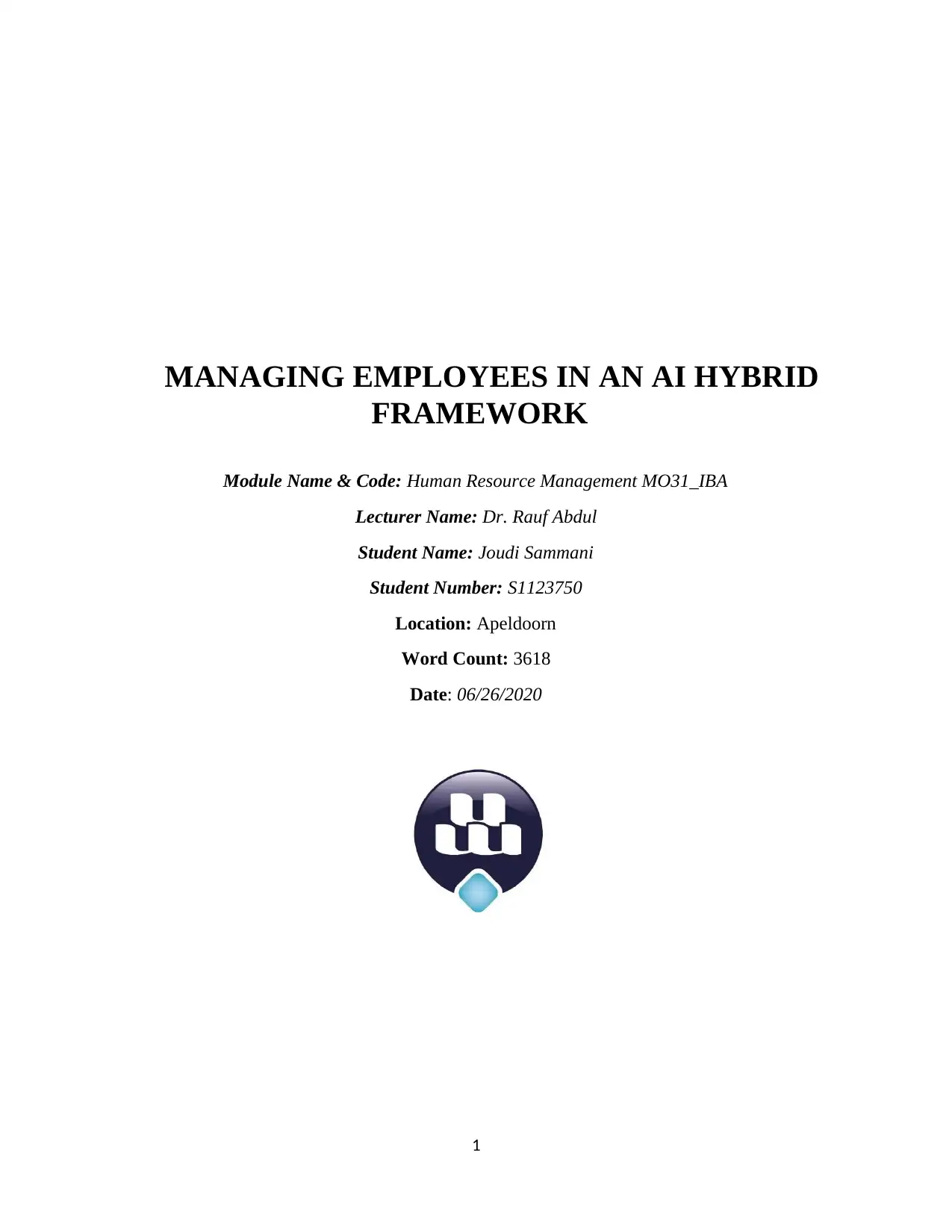
1
MANAGING EMPLOYEES IN AN AI HYBRID
FRAMEWORK
Module Name & Code: Human Resource Management MO31_IBA
Lecturer Name: Dr. Rauf Abdul
Student Name: Joudi Sammani
Student Number: S1123750
Location: Apeldoorn
Word Count: 3618
Date: 06/26/2020
MANAGING EMPLOYEES IN AN AI HYBRID
FRAMEWORK
Module Name & Code: Human Resource Management MO31_IBA
Lecturer Name: Dr. Rauf Abdul
Student Name: Joudi Sammani
Student Number: S1123750
Location: Apeldoorn
Word Count: 3618
Date: 06/26/2020
Paraphrase This Document
Need a fresh take? Get an instant paraphrase of this document with our AI Paraphraser
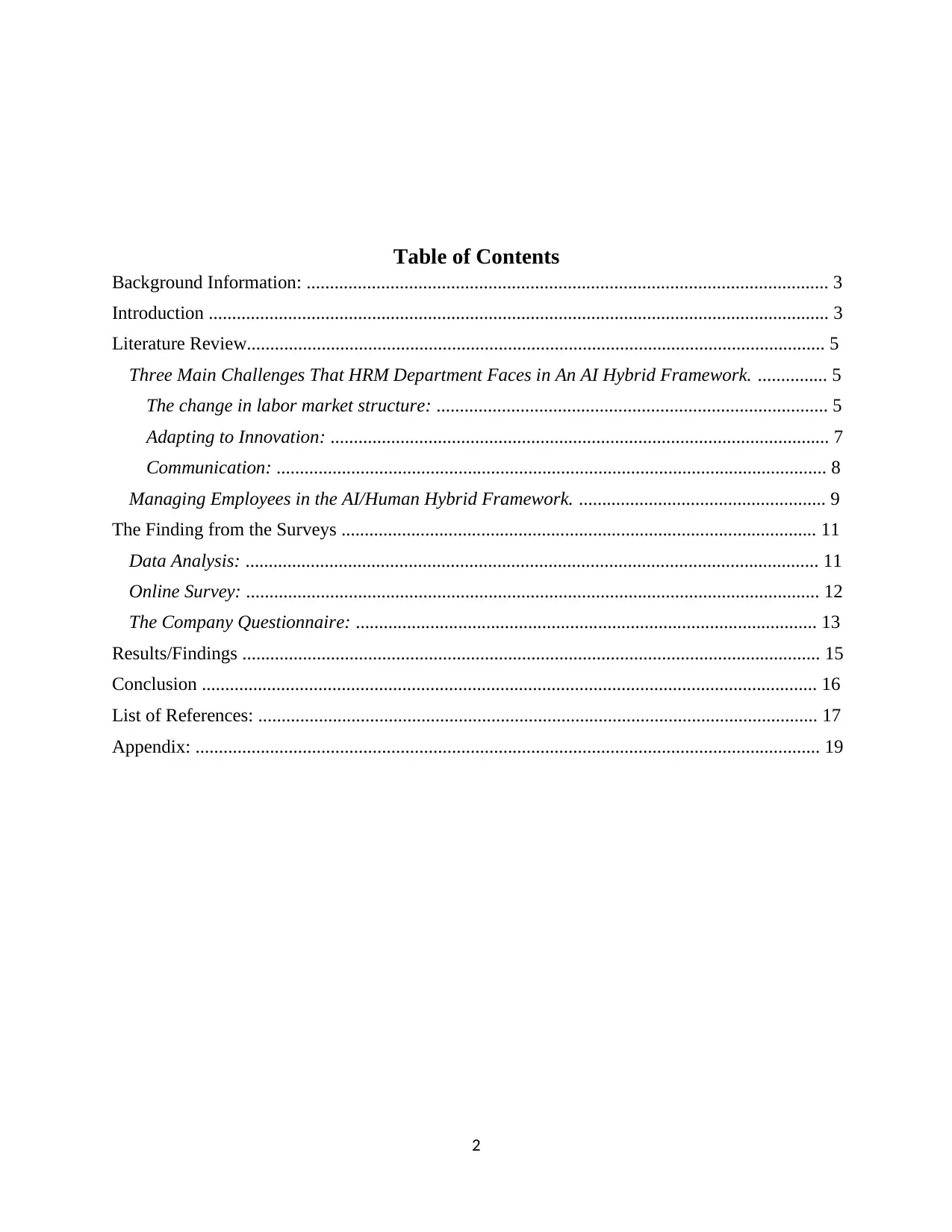
2
Table of Contents
Background Information: ................................................................................................................ 3
Introduction ..................................................................................................................................... 3
Literature Review............................................................................................................................ 5
Three Main Challenges That HRM Department Faces in An AI Hybrid Framework. ............... 5
The change in labor market structure: .................................................................................... 5
Adapting to Innovation: ........................................................................................................... 7
Communication: ...................................................................................................................... 8
Managing Employees in the AI/Human Hybrid Framework. ..................................................... 9
The Finding from the Surveys ...................................................................................................... 11
Data Analysis: ........................................................................................................................... 11
Online Survey: ........................................................................................................................... 12
The Company Questionnaire: ................................................................................................... 13
Results/Findings ............................................................................................................................ 15
Conclusion .................................................................................................................................... 16
List of References: ........................................................................................................................ 17
Appendix: ...................................................................................................................................... 19
Table of Contents
Background Information: ................................................................................................................ 3
Introduction ..................................................................................................................................... 3
Literature Review............................................................................................................................ 5
Three Main Challenges That HRM Department Faces in An AI Hybrid Framework. ............... 5
The change in labor market structure: .................................................................................... 5
Adapting to Innovation: ........................................................................................................... 7
Communication: ...................................................................................................................... 8
Managing Employees in the AI/Human Hybrid Framework. ..................................................... 9
The Finding from the Surveys ...................................................................................................... 11
Data Analysis: ........................................................................................................................... 11
Online Survey: ........................................................................................................................... 12
The Company Questionnaire: ................................................................................................... 13
Results/Findings ............................................................................................................................ 15
Conclusion .................................................................................................................................... 16
List of References: ........................................................................................................................ 17
Appendix: ...................................................................................................................................... 19
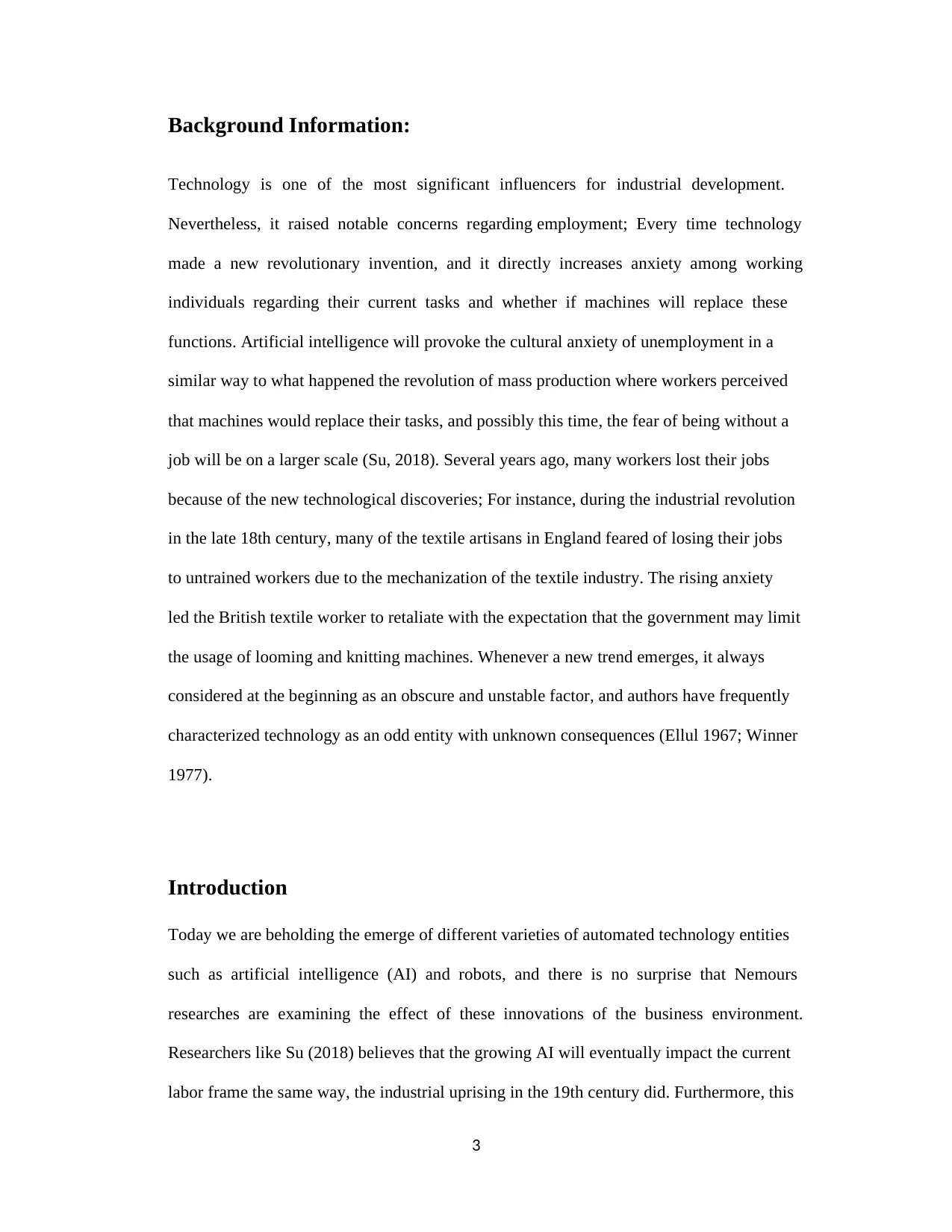
3
Background Information:
Technology is one of the most significant influencers for industrial development.
Nevertheless, it raised notable concerns regarding employment; Every time technology
made a new revolutionary invention, and it directly increases anxiety among working
individuals regarding their current tasks and whether if machines will replace these
functions. Artificial intelligence will provoke the cultural anxiety of unemployment in a
similar way to what happened the revolution of mass production where workers perceived
that machines would replace their tasks, and possibly this time, the fear of being without a
job will be on a larger scale (Su, 2018). Several years ago, many workers lost their jobs
because of the new technological discoveries; For instance, during the industrial revolution
in the late 18th century, many of the textile artisans in England feared of losing their jobs
to untrained workers due to the mechanization of the textile industry. The rising anxiety
led the British textile worker to retaliate with the expectation that the government may limit
the usage of looming and knitting machines. Whenever a new trend emerges, it always
considered at the beginning as an obscure and unstable factor, and authors have frequently
characterized technology as an odd entity with unknown consequences (Ellul 1967; Winner
1977).
Introduction
Today we are beholding the emerge of different varieties of automated technology entities
such as artificial intelligence (AI) and robots, and there is no surprise that Nemours
researches are examining the effect of these innovations of the business environment.
Researchers like Su (2018) believes that the growing AI will eventually impact the current
labor frame the same way, the industrial uprising in the 19th century did. Furthermore, this
Background Information:
Technology is one of the most significant influencers for industrial development.
Nevertheless, it raised notable concerns regarding employment; Every time technology
made a new revolutionary invention, and it directly increases anxiety among working
individuals regarding their current tasks and whether if machines will replace these
functions. Artificial intelligence will provoke the cultural anxiety of unemployment in a
similar way to what happened the revolution of mass production where workers perceived
that machines would replace their tasks, and possibly this time, the fear of being without a
job will be on a larger scale (Su, 2018). Several years ago, many workers lost their jobs
because of the new technological discoveries; For instance, during the industrial revolution
in the late 18th century, many of the textile artisans in England feared of losing their jobs
to untrained workers due to the mechanization of the textile industry. The rising anxiety
led the British textile worker to retaliate with the expectation that the government may limit
the usage of looming and knitting machines. Whenever a new trend emerges, it always
considered at the beginning as an obscure and unstable factor, and authors have frequently
characterized technology as an odd entity with unknown consequences (Ellul 1967; Winner
1977).
Introduction
Today we are beholding the emerge of different varieties of automated technology entities
such as artificial intelligence (AI) and robots, and there is no surprise that Nemours
researches are examining the effect of these innovations of the business environment.
Researchers like Su (2018) believes that the growing AI will eventually impact the current
labor frame the same way, the industrial uprising in the 19th century did. Furthermore, this
⊘ This is a preview!⊘
Do you want full access?
Subscribe today to unlock all pages.

Trusted by 1+ million students worldwide
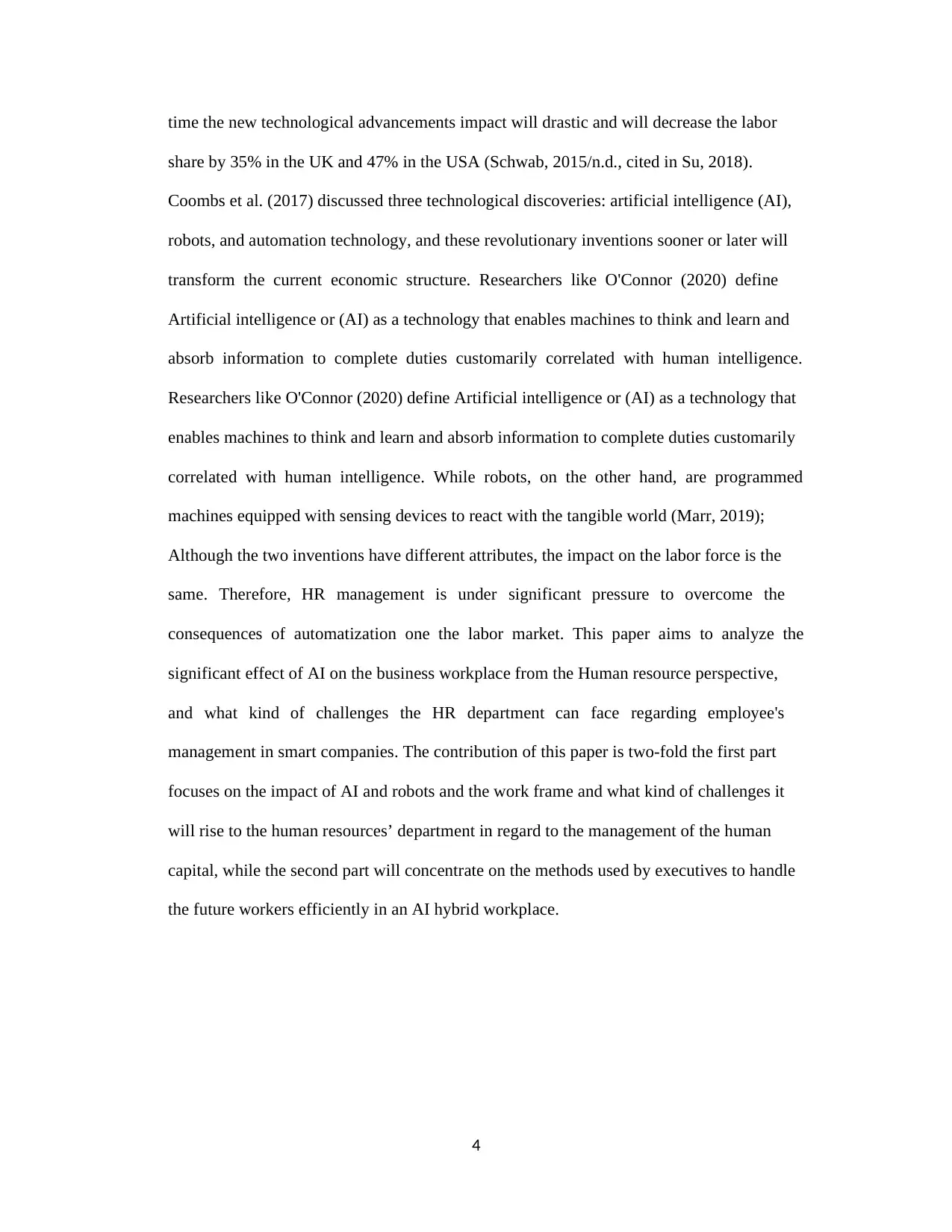
4
time the new technological advancements impact will drastic and will decrease the labor
share by 35% in the UK and 47% in the USA (Schwab, 2015/n.d., cited in Su, 2018).
Coombs et al. (2017) discussed three technological discoveries: artificial intelligence (AI),
robots, and automation technology, and these revolutionary inventions sooner or later will
transform the current economic structure. Researchers like O'Connor (2020) define
Artificial intelligence or (AI) as a technology that enables machines to think and learn and
absorb information to complete duties customarily correlated with human intelligence.
Researchers like O'Connor (2020) define Artificial intelligence or (AI) as a technology that
enables machines to think and learn and absorb information to complete duties customarily
correlated with human intelligence. While robots, on the other hand, are programmed
machines equipped with sensing devices to react with the tangible world (Marr, 2019);
Although the two inventions have different attributes, the impact on the labor force is the
same. Therefore, HR management is under significant pressure to overcome the
consequences of automatization one the labor market. This paper aims to analyze the
significant effect of AI on the business workplace from the Human resource perspective,
and what kind of challenges the HR department can face regarding employee's
management in smart companies. The contribution of this paper is two-fold the first part
focuses on the impact of AI and robots and the work frame and what kind of challenges it
will rise to the human resources’ department in regard to the management of the human
capital, while the second part will concentrate on the methods used by executives to handle
the future workers efficiently in an AI hybrid workplace.
time the new technological advancements impact will drastic and will decrease the labor
share by 35% in the UK and 47% in the USA (Schwab, 2015/n.d., cited in Su, 2018).
Coombs et al. (2017) discussed three technological discoveries: artificial intelligence (AI),
robots, and automation technology, and these revolutionary inventions sooner or later will
transform the current economic structure. Researchers like O'Connor (2020) define
Artificial intelligence or (AI) as a technology that enables machines to think and learn and
absorb information to complete duties customarily correlated with human intelligence.
Researchers like O'Connor (2020) define Artificial intelligence or (AI) as a technology that
enables machines to think and learn and absorb information to complete duties customarily
correlated with human intelligence. While robots, on the other hand, are programmed
machines equipped with sensing devices to react with the tangible world (Marr, 2019);
Although the two inventions have different attributes, the impact on the labor force is the
same. Therefore, HR management is under significant pressure to overcome the
consequences of automatization one the labor market. This paper aims to analyze the
significant effect of AI on the business workplace from the Human resource perspective,
and what kind of challenges the HR department can face regarding employee's
management in smart companies. The contribution of this paper is two-fold the first part
focuses on the impact of AI and robots and the work frame and what kind of challenges it
will rise to the human resources’ department in regard to the management of the human
capital, while the second part will concentrate on the methods used by executives to handle
the future workers efficiently in an AI hybrid workplace.
Paraphrase This Document
Need a fresh take? Get an instant paraphrase of this document with our AI Paraphraser
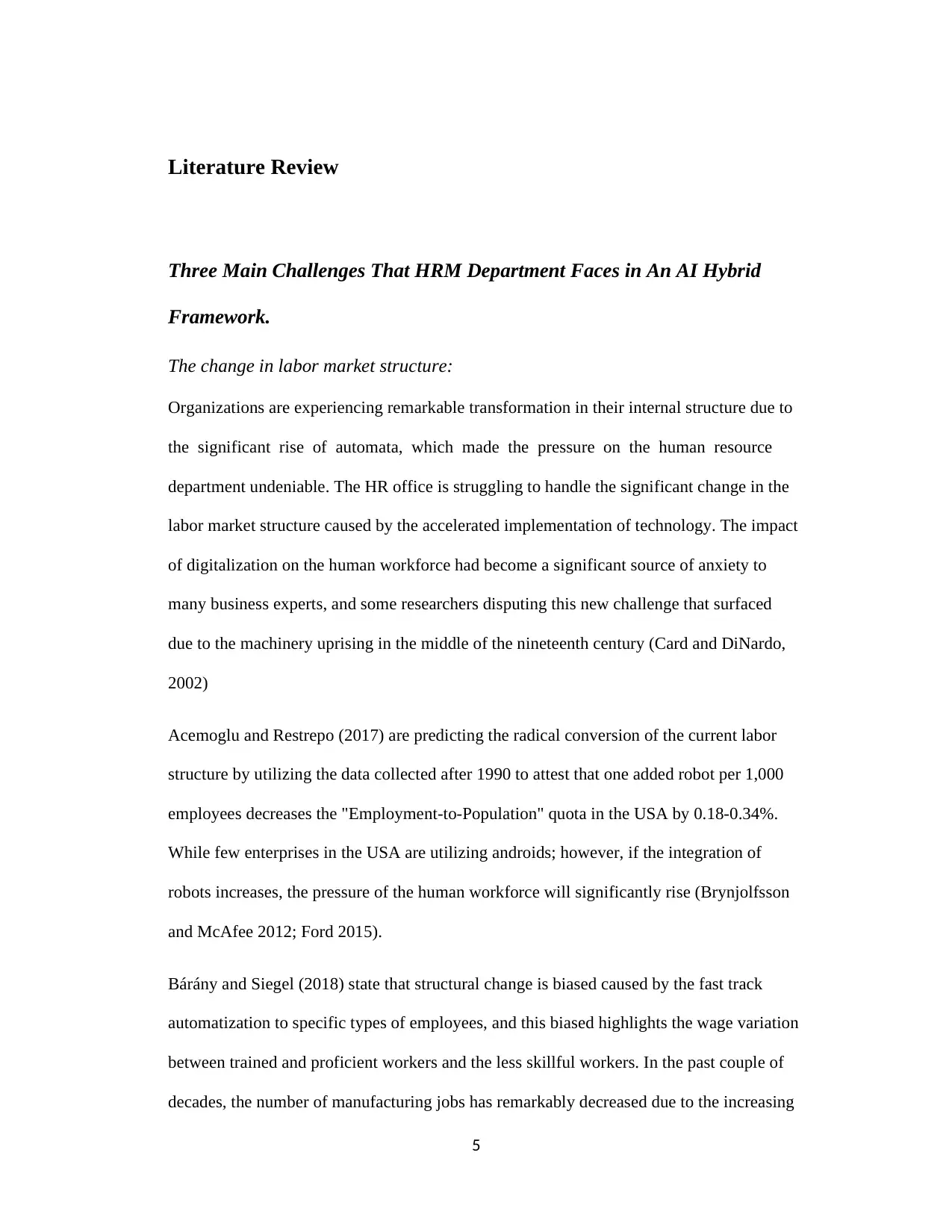
5
Literature Review
Three Main Challenges That HRM Department Faces in An AI Hybrid
Framework.
The change in labor market structure:
Organizations are experiencing remarkable transformation in their internal structure due to
the significant rise of automata, which made the pressure on the human resource
department undeniable. The HR office is struggling to handle the significant change in the
labor market structure caused by the accelerated implementation of technology. The impact
of digitalization on the human workforce had become a significant source of anxiety to
many business experts, and some researchers disputing this new challenge that surfaced
due to the machinery uprising in the middle of the nineteenth century (Card and DiNardo,
2002)
Acemoglu and Restrepo (2017) are predicting the radical conversion of the current labor
structure by utilizing the data collected after 1990 to attest that one added robot per 1,000
employees decreases the "Employment-to-Population" quota in the USA by 0.18-0.34%.
While few enterprises in the USA are utilizing androids; however, if the integration of
robots increases, the pressure of the human workforce will significantly rise (Brynjolfsson
and McAfee 2012; Ford 2015).
Bárány and Siegel (2018) state that structural change is biased caused by the fast track
automatization to specific types of employees, and this biased highlights the wage variation
between trained and proficient workers and the less skillful workers. In the past couple of
decades, the number of manufacturing jobs has remarkably decreased due to the increasing
Literature Review
Three Main Challenges That HRM Department Faces in An AI Hybrid
Framework.
The change in labor market structure:
Organizations are experiencing remarkable transformation in their internal structure due to
the significant rise of automata, which made the pressure on the human resource
department undeniable. The HR office is struggling to handle the significant change in the
labor market structure caused by the accelerated implementation of technology. The impact
of digitalization on the human workforce had become a significant source of anxiety to
many business experts, and some researchers disputing this new challenge that surfaced
due to the machinery uprising in the middle of the nineteenth century (Card and DiNardo,
2002)
Acemoglu and Restrepo (2017) are predicting the radical conversion of the current labor
structure by utilizing the data collected after 1990 to attest that one added robot per 1,000
employees decreases the "Employment-to-Population" quota in the USA by 0.18-0.34%.
While few enterprises in the USA are utilizing androids; however, if the integration of
robots increases, the pressure of the human workforce will significantly rise (Brynjolfsson
and McAfee 2012; Ford 2015).
Bárány and Siegel (2018) state that structural change is biased caused by the fast track
automatization to specific types of employees, and this biased highlights the wage variation
between trained and proficient workers and the less skillful workers. In the past couple of
decades, the number of manufacturing jobs has remarkably decreased due to the increasing
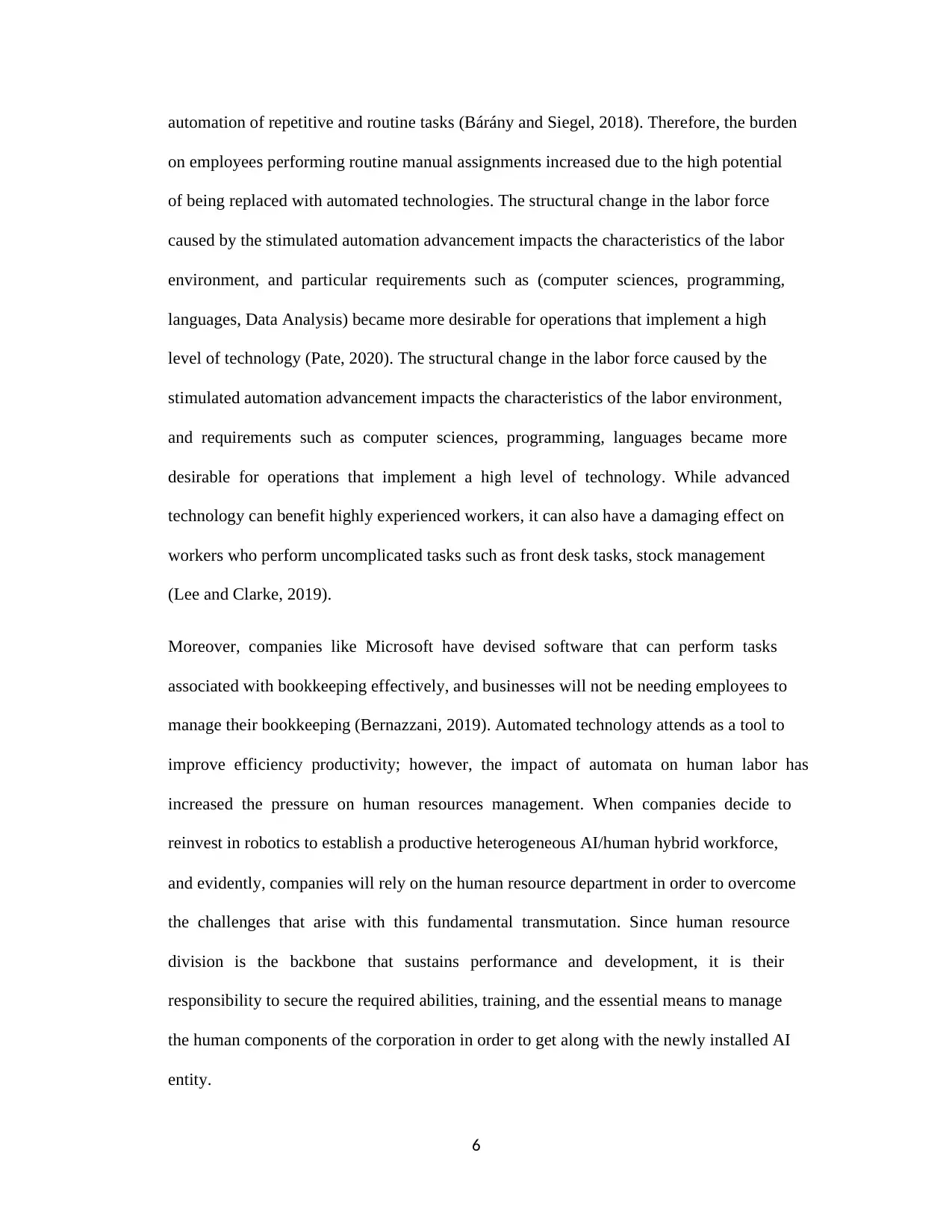
6
automation of repetitive and routine tasks (Bárány and Siegel, 2018). Therefore, the burden
on employees performing routine manual assignments increased due to the high potential
of being replaced with automated technologies. The structural change in the labor force
caused by the stimulated automation advancement impacts the characteristics of the labor
environment, and particular requirements such as (computer sciences, programming,
languages, Data Analysis) became more desirable for operations that implement a high
level of technology (Pate, 2020). The structural change in the labor force caused by the
stimulated automation advancement impacts the characteristics of the labor environment,
and requirements such as computer sciences, programming, languages became more
desirable for operations that implement a high level of technology. While advanced
technology can benefit highly experienced workers, it can also have a damaging effect on
workers who perform uncomplicated tasks such as front desk tasks, stock management
(Lee and Clarke, 2019).
Moreover, companies like Microsoft have devised software that can perform tasks
associated with bookkeeping effectively, and businesses will not be needing employees to
manage their bookkeeping (Bernazzani, 2019). Automated technology attends as a tool to
improve efficiency productivity; however, the impact of automata on human labor has
increased the pressure on human resources management. When companies decide to
reinvest in robotics to establish a productive heterogeneous AI/human hybrid workforce,
and evidently, companies will rely on the human resource department in order to overcome
the challenges that arise with this fundamental transmutation. Since human resource
division is the backbone that sustains performance and development, it is their
responsibility to secure the required abilities, training, and the essential means to manage
the human components of the corporation in order to get along with the newly installed AI
entity.
automation of repetitive and routine tasks (Bárány and Siegel, 2018). Therefore, the burden
on employees performing routine manual assignments increased due to the high potential
of being replaced with automated technologies. The structural change in the labor force
caused by the stimulated automation advancement impacts the characteristics of the labor
environment, and particular requirements such as (computer sciences, programming,
languages, Data Analysis) became more desirable for operations that implement a high
level of technology (Pate, 2020). The structural change in the labor force caused by the
stimulated automation advancement impacts the characteristics of the labor environment,
and requirements such as computer sciences, programming, languages became more
desirable for operations that implement a high level of technology. While advanced
technology can benefit highly experienced workers, it can also have a damaging effect on
workers who perform uncomplicated tasks such as front desk tasks, stock management
(Lee and Clarke, 2019).
Moreover, companies like Microsoft have devised software that can perform tasks
associated with bookkeeping effectively, and businesses will not be needing employees to
manage their bookkeeping (Bernazzani, 2019). Automated technology attends as a tool to
improve efficiency productivity; however, the impact of automata on human labor has
increased the pressure on human resources management. When companies decide to
reinvest in robotics to establish a productive heterogeneous AI/human hybrid workforce,
and evidently, companies will rely on the human resource department in order to overcome
the challenges that arise with this fundamental transmutation. Since human resource
division is the backbone that sustains performance and development, it is their
responsibility to secure the required abilities, training, and the essential means to manage
the human components of the corporation in order to get along with the newly installed AI
entity.
⊘ This is a preview!⊘
Do you want full access?
Subscribe today to unlock all pages.

Trusted by 1+ million students worldwide
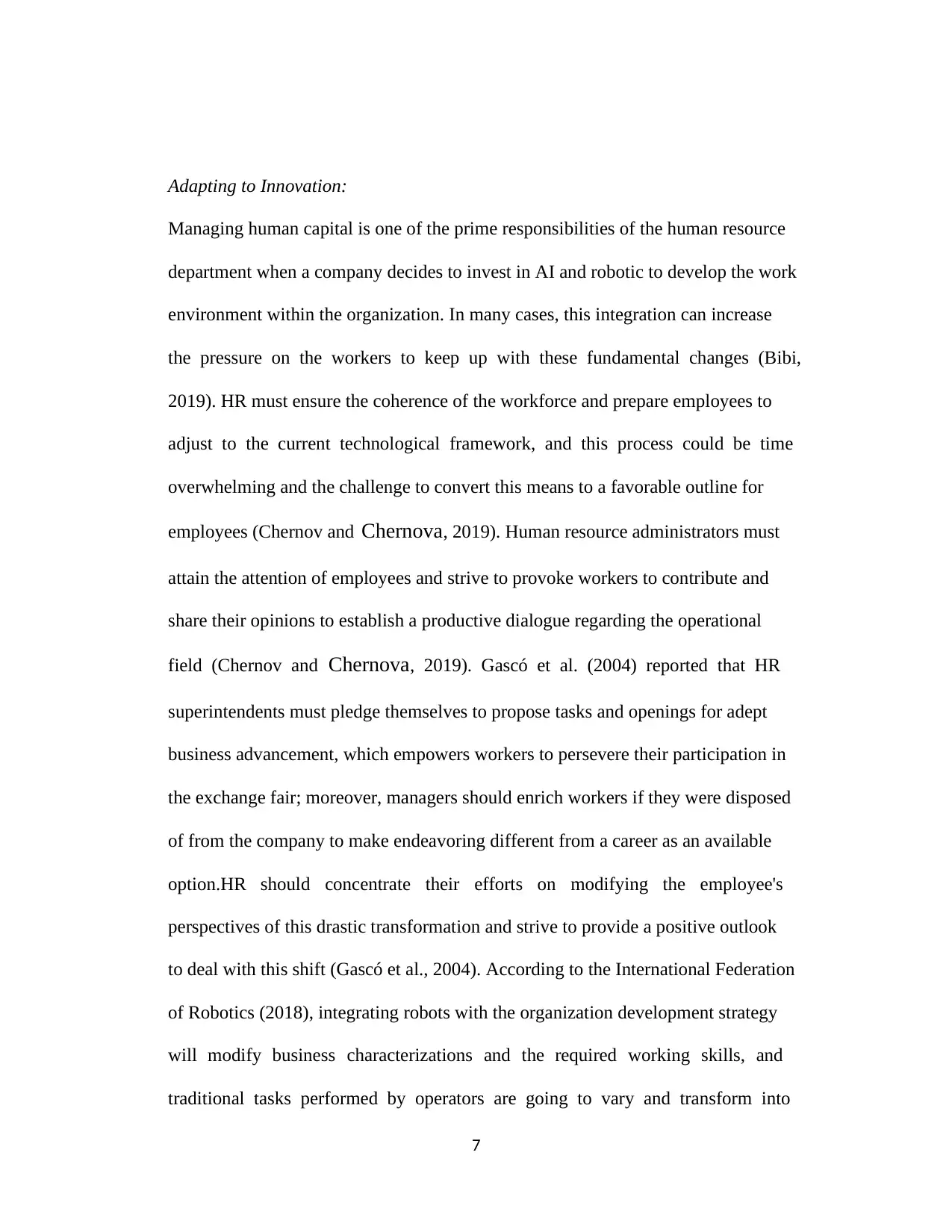
7
Adapting to Innovation:
Managing human capital is one of the prime responsibilities of the human resource
department when a company decides to invest in AI and robotic to develop the work
environment within the organization. In many cases, this integration can increase
the pressure on the workers to keep up with these fundamental changes (Bibi,
2019). HR must ensure the coherence of the workforce and prepare employees to
adjust to the current technological framework, and this process could be time
overwhelming and the challenge to convert this means to a favorable outline for
employees (Chernov and Chernova, 2019). Human resource administrators must
attain the attention of employees and strive to provoke workers to contribute and
share their opinions to establish a productive dialogue regarding the operational
field (Chernov and Chernova, 2019). Gascó et al. (2004) reported that HR
superintendents must pledge themselves to propose tasks and openings for adept
business advancement, which empowers workers to persevere their participation in
the exchange fair; moreover, managers should enrich workers if they were disposed
of from the company to make endeavoring different from a career as an available
option.HR should concentrate their efforts on modifying the employee's
perspectives of this drastic transformation and strive to provide a positive outlook
to deal with this shift (Gascó et al., 2004). According to the International Federation
of Robotics (2018), integrating robots with the organization development strategy
will modify business characterizations and the required working skills, and
traditional tasks performed by operators are going to vary and transform into
Adapting to Innovation:
Managing human capital is one of the prime responsibilities of the human resource
department when a company decides to invest in AI and robotic to develop the work
environment within the organization. In many cases, this integration can increase
the pressure on the workers to keep up with these fundamental changes (Bibi,
2019). HR must ensure the coherence of the workforce and prepare employees to
adjust to the current technological framework, and this process could be time
overwhelming and the challenge to convert this means to a favorable outline for
employees (Chernov and Chernova, 2019). Human resource administrators must
attain the attention of employees and strive to provoke workers to contribute and
share their opinions to establish a productive dialogue regarding the operational
field (Chernov and Chernova, 2019). Gascó et al. (2004) reported that HR
superintendents must pledge themselves to propose tasks and openings for adept
business advancement, which empowers workers to persevere their participation in
the exchange fair; moreover, managers should enrich workers if they were disposed
of from the company to make endeavoring different from a career as an available
option.HR should concentrate their efforts on modifying the employee's
perspectives of this drastic transformation and strive to provide a positive outlook
to deal with this shift (Gascó et al., 2004). According to the International Federation
of Robotics (2018), integrating robots with the organization development strategy
will modify business characterizations and the required working skills, and
traditional tasks performed by operators are going to vary and transform into
Paraphrase This Document
Need a fresh take? Get an instant paraphrase of this document with our AI Paraphraser
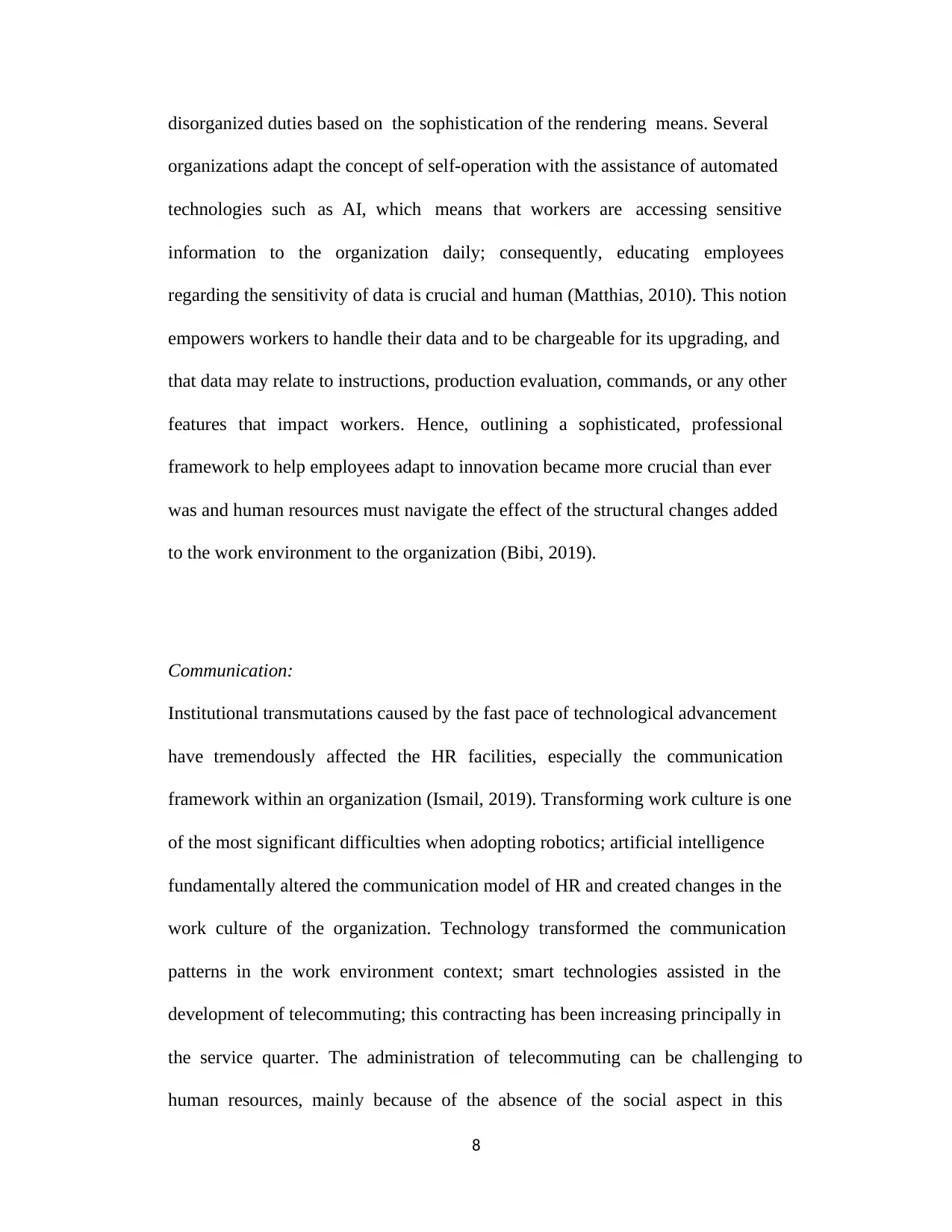
8
disorganized duties based on the sophistication of the rendering means. Several
organizations adapt the concept of self-operation with the assistance of automated
technologies such as AI, which means that workers are accessing sensitive
information to the organization daily; consequently, educating employees
regarding the sensitivity of data is crucial and human (Matthias, 2010). This notion
empowers workers to handle their data and to be chargeable for its upgrading, and
that data may relate to instructions, production evaluation, commands, or any other
features that impact workers. Hence, outlining a sophisticated, professional
framework to help employees adapt to innovation became more crucial than ever
was and human resources must navigate the effect of the structural changes added
to the work environment to the organization (Bibi, 2019).
Communication:
Institutional transmutations caused by the fast pace of technological advancement
have tremendously affected the HR facilities, especially the communication
framework within an organization (Ismail, 2019). Transforming work culture is one
of the most significant difficulties when adopting robotics; artificial intelligence
fundamentally altered the communication model of HR and created changes in the
work culture of the organization. Technology transformed the communication
patterns in the work environment context; smart technologies assisted in the
development of telecommuting; this contracting has been increasing principally in
the service quarter. The administration of telecommuting can be challenging to
human resources, mainly because of the absence of the social aspect in this
disorganized duties based on the sophistication of the rendering means. Several
organizations adapt the concept of self-operation with the assistance of automated
technologies such as AI, which means that workers are accessing sensitive
information to the organization daily; consequently, educating employees
regarding the sensitivity of data is crucial and human (Matthias, 2010). This notion
empowers workers to handle their data and to be chargeable for its upgrading, and
that data may relate to instructions, production evaluation, commands, or any other
features that impact workers. Hence, outlining a sophisticated, professional
framework to help employees adapt to innovation became more crucial than ever
was and human resources must navigate the effect of the structural changes added
to the work environment to the organization (Bibi, 2019).
Communication:
Institutional transmutations caused by the fast pace of technological advancement
have tremendously affected the HR facilities, especially the communication
framework within an organization (Ismail, 2019). Transforming work culture is one
of the most significant difficulties when adopting robotics; artificial intelligence
fundamentally altered the communication model of HR and created changes in the
work culture of the organization. Technology transformed the communication
patterns in the work environment context; smart technologies assisted in the
development of telecommuting; this contracting has been increasing principally in
the service quarter. The administration of telecommuting can be challenging to
human resources, mainly because of the absence of the social aspect in this
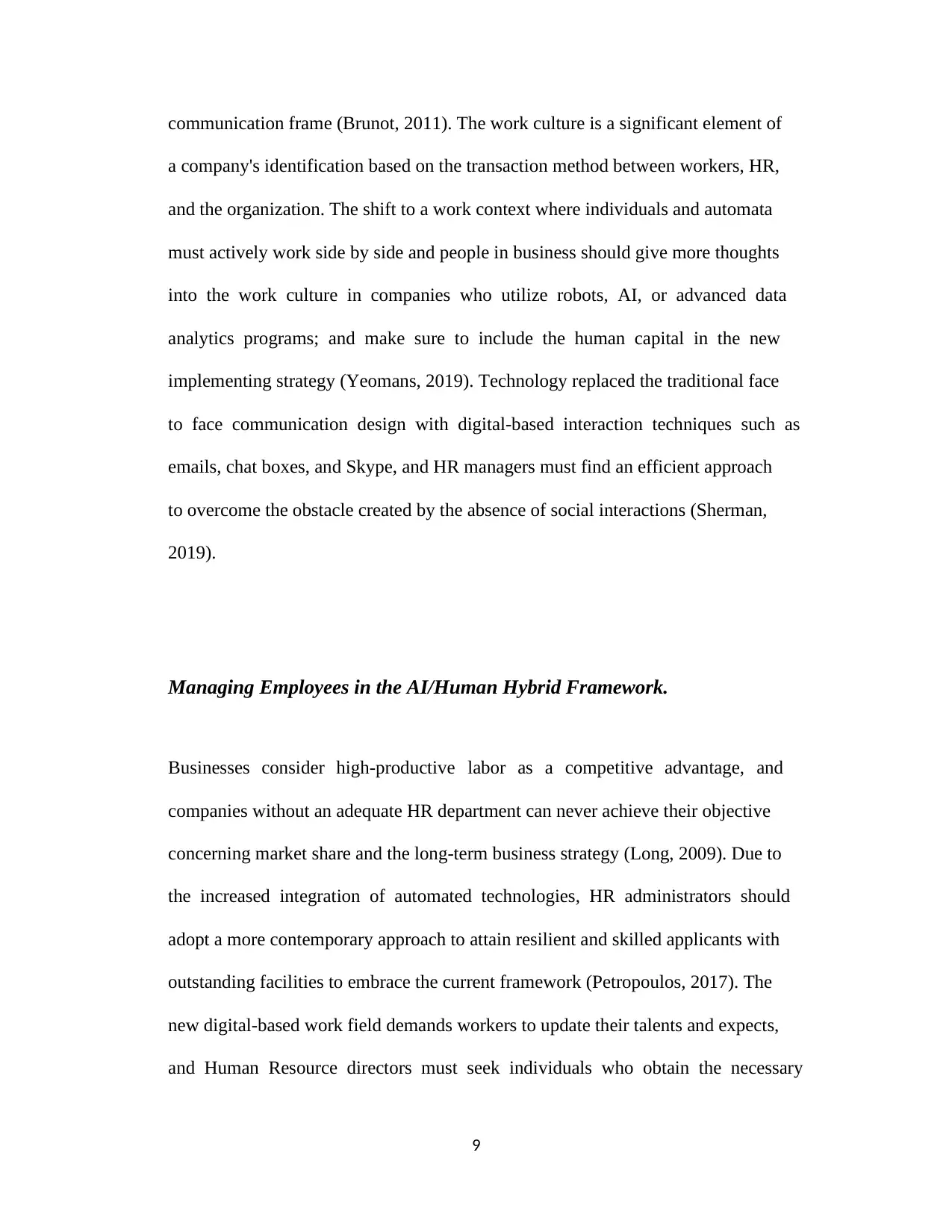
9
communication frame (Brunot, 2011). The work culture is a significant element of
a company's identification based on the transaction method between workers, HR,
and the organization. The shift to a work context where individuals and automata
must actively work side by side and people in business should give more thoughts
into the work culture in companies who utilize robots, AI, or advanced data
analytics programs; and make sure to include the human capital in the new
implementing strategy (Yeomans, 2019). Technology replaced the traditional face
to face communication design with digital-based interaction techniques such as
emails, chat boxes, and Skype, and HR managers must find an efficient approach
to overcome the obstacle created by the absence of social interactions (Sherman,
2019).
Managing Employees in the AI/Human Hybrid Framework.
Businesses consider high-productive labor as a competitive advantage, and
companies without an adequate HR department can never achieve their objective
concerning market share and the long-term business strategy (Long, 2009). Due to
the increased integration of automated technologies, HR administrators should
adopt a more contemporary approach to attain resilient and skilled applicants with
outstanding facilities to embrace the current framework (Petropoulos, 2017). The
new digital-based work field demands workers to update their talents and expects,
and Human Resource directors must seek individuals who obtain the necessary
communication frame (Brunot, 2011). The work culture is a significant element of
a company's identification based on the transaction method between workers, HR,
and the organization. The shift to a work context where individuals and automata
must actively work side by side and people in business should give more thoughts
into the work culture in companies who utilize robots, AI, or advanced data
analytics programs; and make sure to include the human capital in the new
implementing strategy (Yeomans, 2019). Technology replaced the traditional face
to face communication design with digital-based interaction techniques such as
emails, chat boxes, and Skype, and HR managers must find an efficient approach
to overcome the obstacle created by the absence of social interactions (Sherman,
2019).
Managing Employees in the AI/Human Hybrid Framework.
Businesses consider high-productive labor as a competitive advantage, and
companies without an adequate HR department can never achieve their objective
concerning market share and the long-term business strategy (Long, 2009). Due to
the increased integration of automated technologies, HR administrators should
adopt a more contemporary approach to attain resilient and skilled applicants with
outstanding facilities to embrace the current framework (Petropoulos, 2017). The
new digital-based work field demands workers to update their talents and expects,
and Human Resource directors must seek individuals who obtain the necessary
⊘ This is a preview!⊘
Do you want full access?
Subscribe today to unlock all pages.

Trusted by 1+ million students worldwide
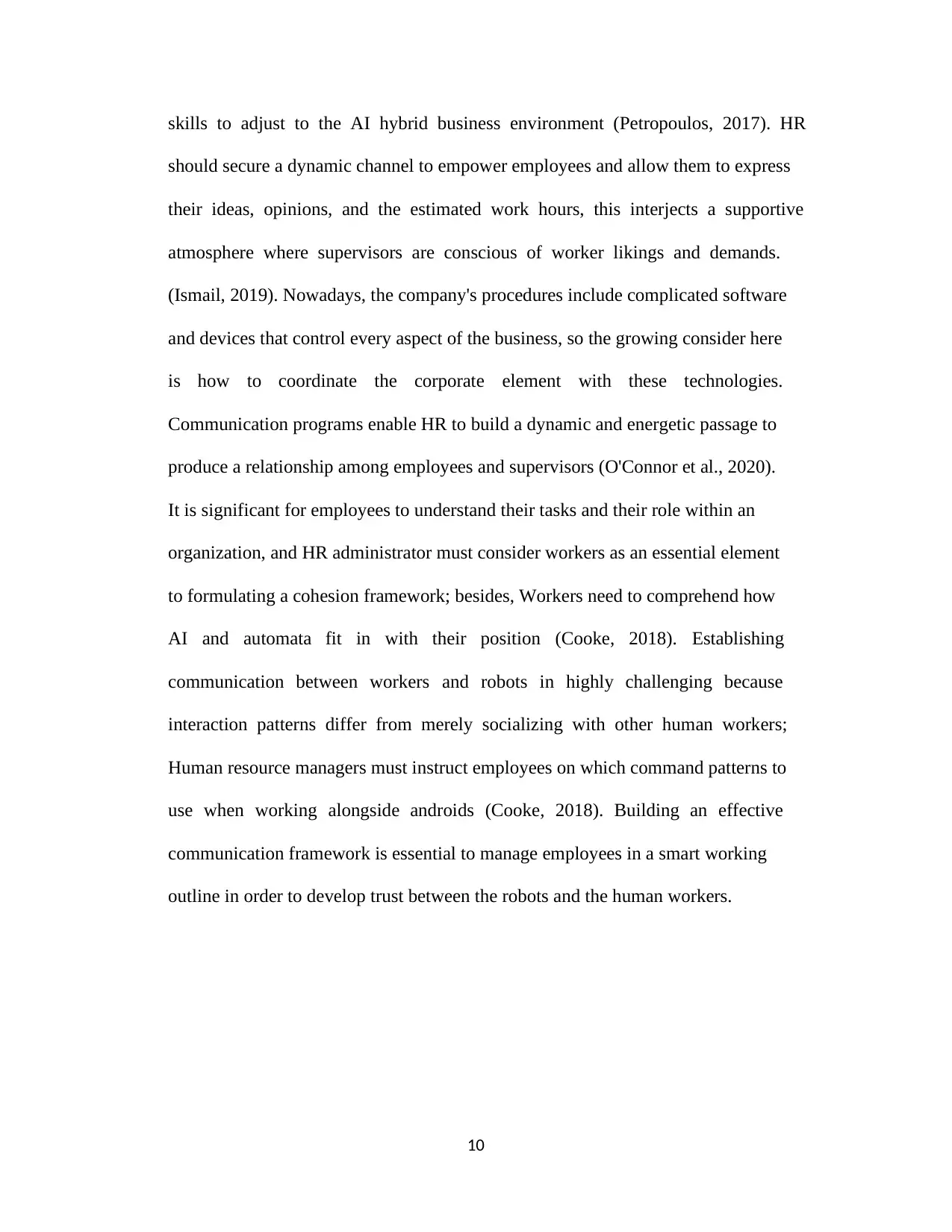
10
skills to adjust to the AI hybrid business environment (Petropoulos, 2017). HR
should secure a dynamic channel to empower employees and allow them to express
their ideas, opinions, and the estimated work hours, this interjects a supportive
atmosphere where supervisors are conscious of worker likings and demands.
(Ismail, 2019). Nowadays, the company's procedures include complicated software
and devices that control every aspect of the business, so the growing consider here
is how to coordinate the corporate element with these technologies.
Communication programs enable HR to build a dynamic and energetic passage to
produce a relationship among employees and supervisors (O'Connor et al., 2020).
It is significant for employees to understand their tasks and their role within an
organization, and HR administrator must consider workers as an essential element
to formulating a cohesion framework; besides, Workers need to comprehend how
AI and automata fit in with their position (Cooke, 2018). Establishing
communication between workers and robots in highly challenging because
interaction patterns differ from merely socializing with other human workers;
Human resource managers must instruct employees on which command patterns to
use when working alongside androids (Cooke, 2018). Building an effective
communication framework is essential to manage employees in a smart working
outline in order to develop trust between the robots and the human workers.
skills to adjust to the AI hybrid business environment (Petropoulos, 2017). HR
should secure a dynamic channel to empower employees and allow them to express
their ideas, opinions, and the estimated work hours, this interjects a supportive
atmosphere where supervisors are conscious of worker likings and demands.
(Ismail, 2019). Nowadays, the company's procedures include complicated software
and devices that control every aspect of the business, so the growing consider here
is how to coordinate the corporate element with these technologies.
Communication programs enable HR to build a dynamic and energetic passage to
produce a relationship among employees and supervisors (O'Connor et al., 2020).
It is significant for employees to understand their tasks and their role within an
organization, and HR administrator must consider workers as an essential element
to formulating a cohesion framework; besides, Workers need to comprehend how
AI and automata fit in with their position (Cooke, 2018). Establishing
communication between workers and robots in highly challenging because
interaction patterns differ from merely socializing with other human workers;
Human resource managers must instruct employees on which command patterns to
use when working alongside androids (Cooke, 2018). Building an effective
communication framework is essential to manage employees in a smart working
outline in order to develop trust between the robots and the human workers.
Paraphrase This Document
Need a fresh take? Get an instant paraphrase of this document with our AI Paraphraser
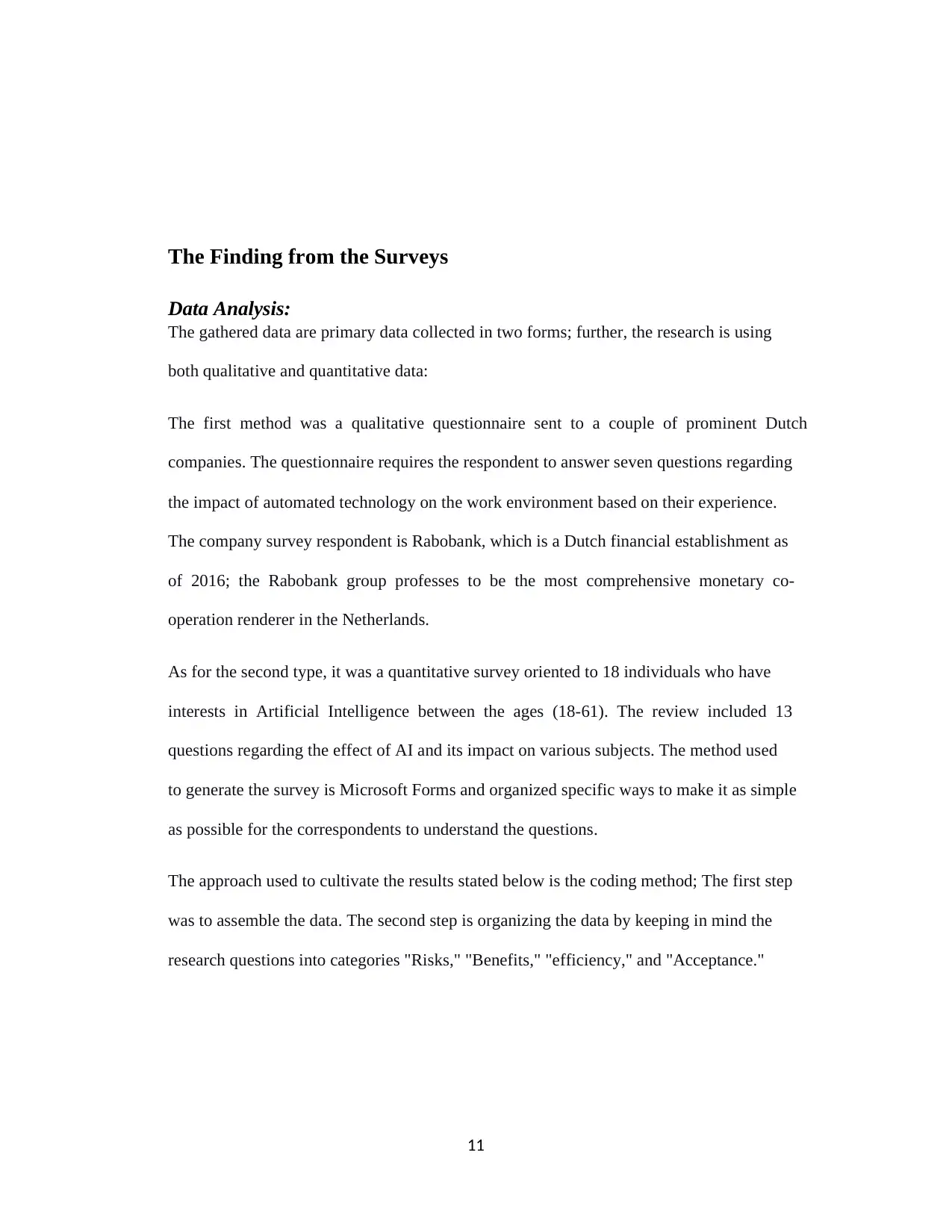
11
The Finding from the Surveys
Data Analysis:
The gathered data are primary data collected in two forms; further, the research is using
both qualitative and quantitative data:
The first method was a qualitative questionnaire sent to a couple of prominent Dutch
companies. The questionnaire requires the respondent to answer seven questions regarding
the impact of automated technology on the work environment based on their experience.
The company survey respondent is Rabobank, which is a Dutch financial establishment as
of 2016; the Rabobank group professes to be the most comprehensive monetary co-
operation renderer in the Netherlands.
As for the second type, it was a quantitative survey oriented to 18 individuals who have
interests in Artificial Intelligence between the ages (18-61). The review included 13
questions regarding the effect of AI and its impact on various subjects. The method used
to generate the survey is Microsoft Forms and organized specific ways to make it as simple
as possible for the correspondents to understand the questions.
The approach used to cultivate the results stated below is the coding method; The first step
was to assemble the data. The second step is organizing the data by keeping in mind the
research questions into categories "Risks," "Benefits," "efficiency," and "Acceptance."
The Finding from the Surveys
Data Analysis:
The gathered data are primary data collected in two forms; further, the research is using
both qualitative and quantitative data:
The first method was a qualitative questionnaire sent to a couple of prominent Dutch
companies. The questionnaire requires the respondent to answer seven questions regarding
the impact of automated technology on the work environment based on their experience.
The company survey respondent is Rabobank, which is a Dutch financial establishment as
of 2016; the Rabobank group professes to be the most comprehensive monetary co-
operation renderer in the Netherlands.
As for the second type, it was a quantitative survey oriented to 18 individuals who have
interests in Artificial Intelligence between the ages (18-61). The review included 13
questions regarding the effect of AI and its impact on various subjects. The method used
to generate the survey is Microsoft Forms and organized specific ways to make it as simple
as possible for the correspondents to understand the questions.
The approach used to cultivate the results stated below is the coding method; The first step
was to assemble the data. The second step is organizing the data by keeping in mind the
research questions into categories "Risks," "Benefits," "efficiency," and "Acceptance."
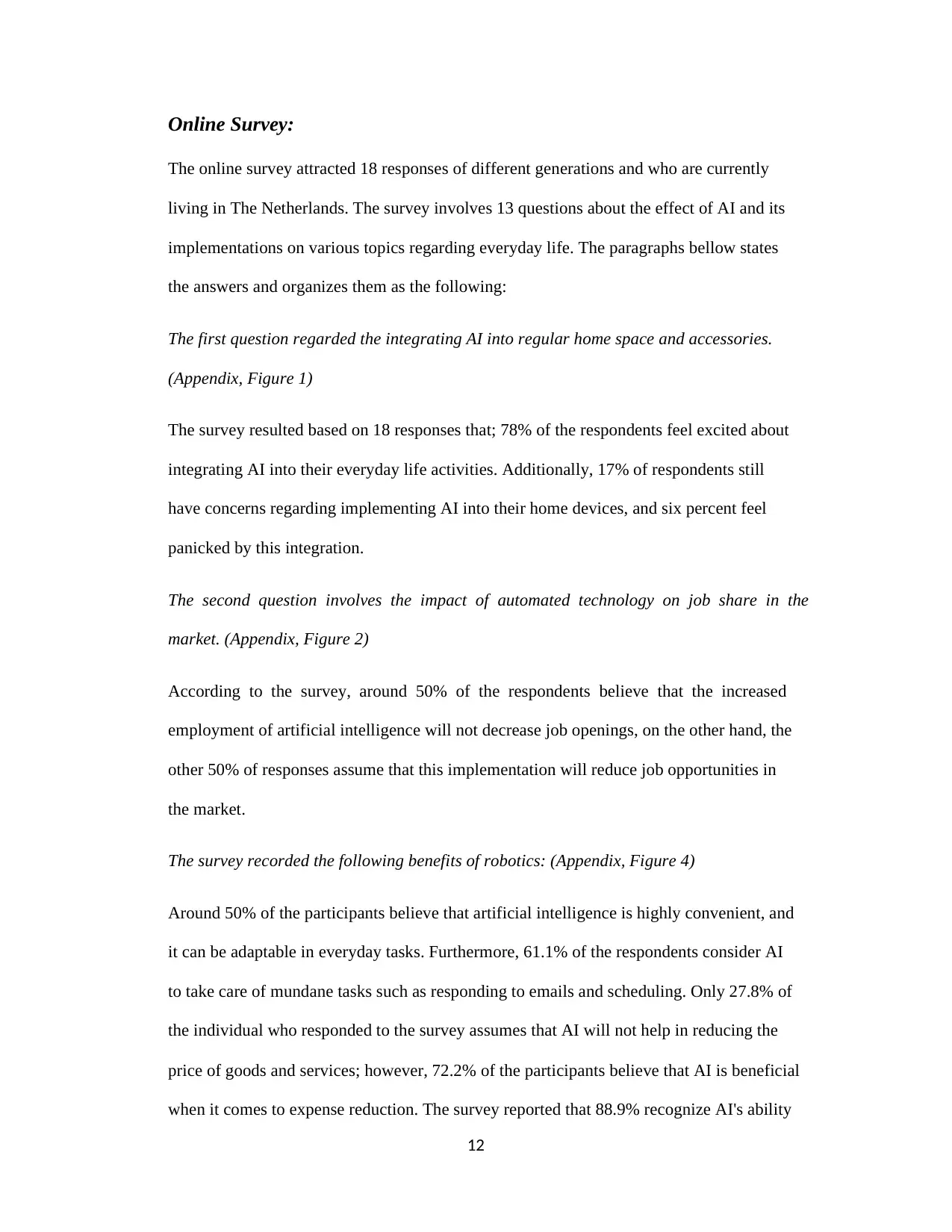
12
Online Survey:
The online survey attracted 18 responses of different generations and who are currently
living in The Netherlands. The survey involves 13 questions about the effect of AI and its
implementations on various topics regarding everyday life. The paragraphs bellow states
the answers and organizes them as the following:
The first question regarded the integrating AI into regular home space and accessories.
(Appendix, Figure 1)
The survey resulted based on 18 responses that; 78% of the respondents feel excited about
integrating AI into their everyday life activities. Additionally, 17% of respondents still
have concerns regarding implementing AI into their home devices, and six percent feel
panicked by this integration.
The second question involves the impact of automated technology on job share in the
market. (Appendix, Figure 2)
According to the survey, around 50% of the respondents believe that the increased
employment of artificial intelligence will not decrease job openings, on the other hand, the
other 50% of responses assume that this implementation will reduce job opportunities in
the market.
The survey recorded the following benefits of robotics: (Appendix, Figure 4)
Around 50% of the participants believe that artificial intelligence is highly convenient, and
it can be adaptable in everyday tasks. Furthermore, 61.1% of the respondents consider AI
to take care of mundane tasks such as responding to emails and scheduling. Only 27.8% of
the individual who responded to the survey assumes that AI will not help in reducing the
price of goods and services; however, 72.2% of the participants believe that AI is beneficial
when it comes to expense reduction. The survey reported that 88.9% recognize AI's ability
Online Survey:
The online survey attracted 18 responses of different generations and who are currently
living in The Netherlands. The survey involves 13 questions about the effect of AI and its
implementations on various topics regarding everyday life. The paragraphs bellow states
the answers and organizes them as the following:
The first question regarded the integrating AI into regular home space and accessories.
(Appendix, Figure 1)
The survey resulted based on 18 responses that; 78% of the respondents feel excited about
integrating AI into their everyday life activities. Additionally, 17% of respondents still
have concerns regarding implementing AI into their home devices, and six percent feel
panicked by this integration.
The second question involves the impact of automated technology on job share in the
market. (Appendix, Figure 2)
According to the survey, around 50% of the respondents believe that the increased
employment of artificial intelligence will not decrease job openings, on the other hand, the
other 50% of responses assume that this implementation will reduce job opportunities in
the market.
The survey recorded the following benefits of robotics: (Appendix, Figure 4)
Around 50% of the participants believe that artificial intelligence is highly convenient, and
it can be adaptable in everyday tasks. Furthermore, 61.1% of the respondents consider AI
to take care of mundane tasks such as responding to emails and scheduling. Only 27.8% of
the individual who responded to the survey assumes that AI will not help in reducing the
price of goods and services; however, 72.2% of the participants believe that AI is beneficial
when it comes to expense reduction. The survey reported that 88.9% recognize AI's ability
⊘ This is a preview!⊘
Do you want full access?
Subscribe today to unlock all pages.

Trusted by 1+ million students worldwide
1 out of 25
Your All-in-One AI-Powered Toolkit for Academic Success.
+13062052269
info@desklib.com
Available 24*7 on WhatsApp / Email
![[object Object]](/_next/static/media/star-bottom.7253800d.svg)
Unlock your academic potential
Copyright © 2020–2025 A2Z Services. All Rights Reserved. Developed and managed by ZUCOL.